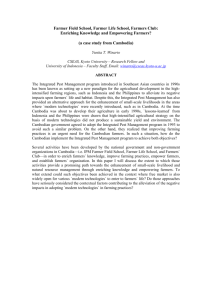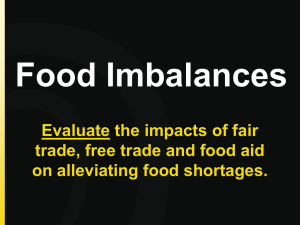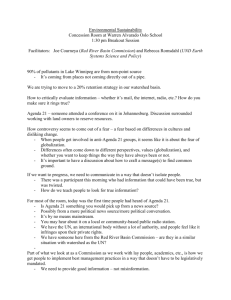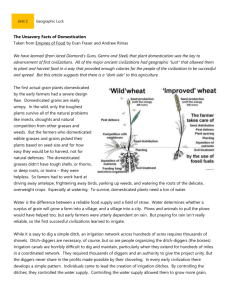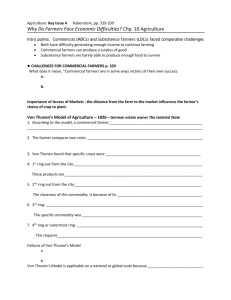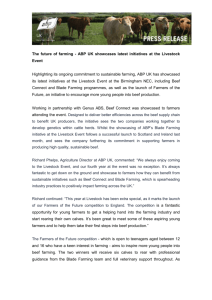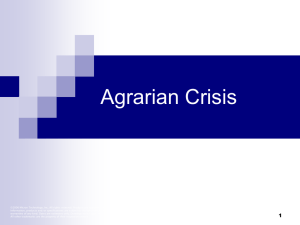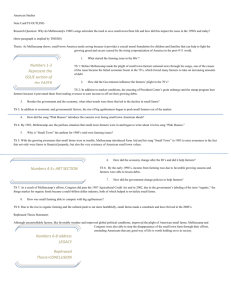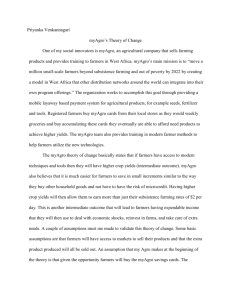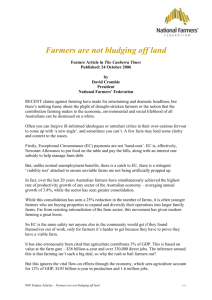COSAMB-Dr.-B.K.Paty_1
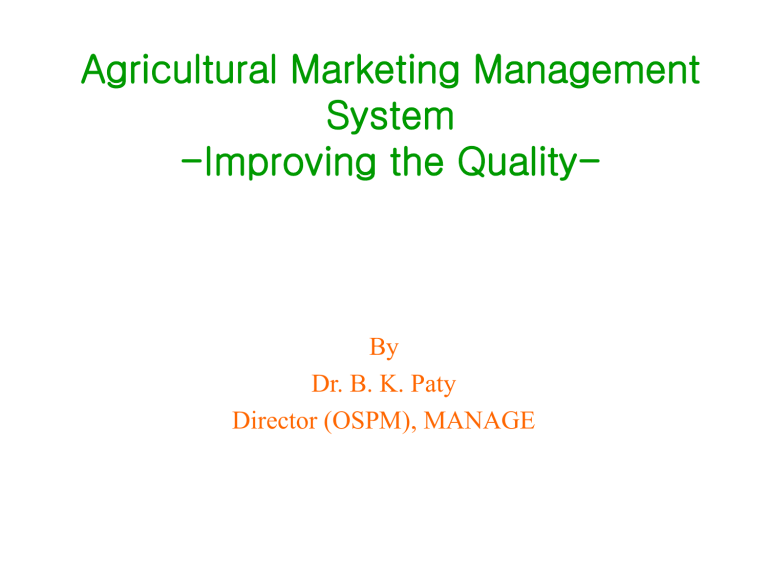
Agricultural Marketing Management
System
-Improving the Quality-
By
Dr. B. K. Paty
Director (OSPM), MANAGE
Outline of the Presentation
• Reforms – No ‘one size fits all approach’
• Service consciousness –
• Linking Production with Marketing
• Collective responsibilities
• Removing the constraints
Reforms – No ‘one size fits all’
• Model Act provisions
• To be calibrated as per the State needs
• Amendments in forms – Not in substance
Service Consciousness
• Mandies deal with service products
• Characteristics – Intangibility,
Simultaneity, Perishability
• Service Consciousness of Mandi
Functionaries – Competitiveness
dealing with a service product
• Marketers of services face a bigger challenge due to unique nature of services-intangibility, heterogeneity, inseparability, perishability
• Go beyond 4 Ps- product, price,promotion and distribution (Place) .Also
– people,
– process and
– physical evidence
Organization
Internal Marketing
External marketing
Front Line
Employees
Internal marketing
Customers
Key Marketing issues
• The unique characteristics of services present some key marketing issues
– Managing differentiation amongst services
(offer, delivery, image, service premises, packaging, personnel, tools and equipment used, customer, convenience, name of the organisation)
– Managing productivity (Commitment, High standards ,
Monitoring system, Customers’ complaint )
– Managing service quality(technology,selection & training, standardisation of services, customer’s involvement, employees’ skill utilisation)
Linking Production with Marketing
• Integrated District Plan – Strategic Research and
Extension Plan (SREP)
• Marketing Extension – Responsibility of all line departments
• The SREP document will be a perspective plan for next 10-15 years
• Ensure optimum utilization of resources
• Help in deciding precise marketing intervention
Collective Responsibilities – All line Departments
• Advice on production planning:- careful selection of the crop from marketability viewpoint-internal or export
• Marketing information:- price and arrivals, forecasting of market trends, demand of other markets, facilities available in the target markets, quality requirements, market fees etc.
• Securing markets for the farmers:-Awareness about regulated market laws and reforms, Information regarding procurement by Govt. agencies, contract farming arrangement for cash crops with wholesalers, processors etc.
• Advice on improved marketing practices:- packaging, appropriate storing methods, standardization and grading and other post harvest management practices such as maintenance of quality, awareness about post-harvest losses etc.
(Contd.,)
Collective Responsibilities – All line Departments
• Advice on establishing and operating markets:-
Farmers groups to set up and run their own markets within framework of rules
• Processing and value addition:-
Farmers to be educated about value addition through primary processing
• Group action:-
Promotion of informal groups and Self Help
Groups(SHGs)
• Marketing Credit:-
Educating farmers about different schemes of marketing credits, Advice on warehousing with pledge finance scheme
• Problem solving methods: micro-level
• Marketing extension for export market
: WTO implications, Codex, HACCP, Euro gap standards, Awareness on ill effects of pesticide/insecticides residue etc.
New Role of APMCs
• Shift from salesmanship to marketing
• Dealing with Service product-intangibility,simultaneity
• Marketing extension
• Promotion of direct marketing, contract farming, processingleading to export, better returns to farmers, reduction of transaction costs etc.
• Promotion of grading and standardization
• Making the traders association responsible
• GAP,HACCP,GHP,traceability etc. especially from export point of view
• Professionalisation of management
• Transparency in dealing/ auctioning
• Providing infrastructure and efficient services ( Promotion of
PPP mode)
Reviewing the Existing Constraints
Issues
• Predominantly marginal or small farmers
• Small quantities of marketable surplus & limited bargaining power
• Poor availability of markets (predominance of
APMCs)
Action Needed
Aggregation of produce needed for value addition
& bargaining power
Farmers to have better market access through
SHGs, Cooperatives, Farmers’ Companies , etc.
Aggregation/ Collection/ Value Addition Centres to be set up near farm gate.
Amendments in State APMR Acts to allow & facilitate alternate channels of marketing with an open choice to farmers
Direct marketing, farmers’ markets, contract farming, private markets, modern terminal markets, e-trading, etc.
Reviewing the Existing Constraint
Issues
• Inadequate infrastructure in wholesale markets/ rural primary markets
Action Needed
• Modernization of existing markets with public investment or through PPP
& facilitating setting up of modern private markets
• Lack of fair price discovery mechanism
• Providing facilities for electronic auction in wholesale markets
• Setting up of e-trading platforms
(both futures & spot ) and
• Mitigating price risk through contract farming
Reviewing the Existing Constraint
Issues
• Multiple and exploitative intermediaries – low returns
Fragmented supply chain, poor cold chain & high post-harvest losses (
Incentives to infrastructure
Action Needed
Encouragement to shortening of supply chain / vertical integration through direct marketing , organized retail chain integrated cold chain with an end to end approach
Terminal Market Complexes ).
• Lack of cleaning, grading, packaging & quality certification facilities
Promotion of aggregation/ consolidation in various ways
Incentive for grading & quality assurance infrastructure
Creation of awareness about quality & food safety standards.
Reviewing the Existing Constraint
Issues
• Multiple agencies involved in quality confirmation & regulation of exports
Action Needed
Creation of single window quality confirmation (Food Safety &
Standards Law already in place)
Single window export clearance systems (APEDA Law amended).
• Limited access to market information and marketing opportunities available
Enriching Marketing Information
Network , strengthen market intelligence delivery under PPP
Activation of Common Service
Centres (CSCs) in villages for easy access to information.
Conclusions
• Utilize ATMA as a collective forum
• Strength lies in Unity
• Key to success lies in holistic approach




